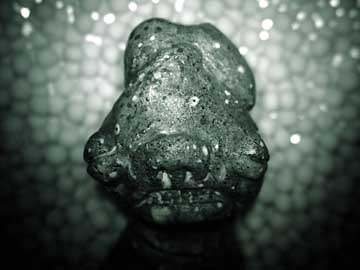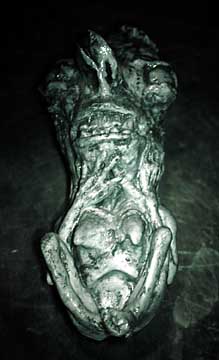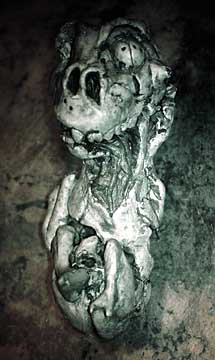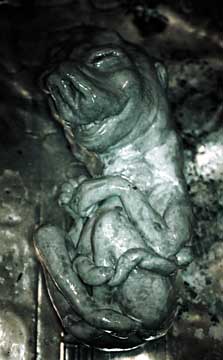 |
Fig. 1 - The head of "George W. Bush, O Mighty One," (no. 1022) allegedly containing traces amounts of brain DNA derived from non-planetary sources, as predicted in the Bible. |
Current Issue Highlights More Readings DA Home About Direct Art
CRITICAL MASSES
(UNCREDITED) ARTIFACTS FROM THE COLLECTION
OF THE UNITED STATES BIOLOGICAL ARCHIVES
By Sam Whitman
 |
Fig. 1 - The head of "George W. Bush, O Mighty One," (no. 1022) allegedly containing traces amounts of brain DNA derived from non-planetary sources, as predicted in the Bible. |
One artist whose career has been profoundly affected by these covert laws and whose artwork has been subjected to frequent and repeated THO’s is the sculptor known as Voltox. Recently, Direct Art Magazine had the opportunity to interview Voltox from his detention cell in the basement of the Pentagon. Due to national security concerns, however, Direct Art Magazine is not permitted to reproduce any portion of that interview without first printing the following disclaimer, as required by sec. 7, para. 4 of BARD II:
The artist known as Voltox has been determined by the United States Biological Archives to be a demented imbecile and a pathological liar whose artwork has been determined not to exist and to be completely lacking in intrinsic artistic merit and/or to have no significance for any purpose consistent with the national security of the United States and/or its allies.
According to Voltox, his artwork first came under the scrutiny of the U.S. Biological Archives program in the months prior to September 11. Voltox had recently completed an exhausting week of testimony in his divorce litigation and, more as a means of relaxation than anything else, had begun working on a small doll-like sculpture, a figurine that he intended to present to his daughter as a birthday present. While working in his studio late one evening, he received a visit from a little man wearing a black beret and an ill-fitting tweed suit that was saturated with resinous dust. The man spoke with a fake french accent and introduced himself as "the chair." Voltox offered the chair a cup of tea and a biscuit, which he accepted, and they chatted politely about art and celebrity gossip for several minutes.
After finishing his tea, the man rose to his feet and produced a document from his vest pocket, which he began to read. The document declared that the doll-like figurine in Voltox’ studio was not a work of art, and had never been a work of art, but was, in fact, "a biological artifact of interest to the national security of the United States." Specifically, it was decreed that the figurine was "a self-sufficient mutant testicular growth illegally removed from the groin of the Vice President of the United States, Mr. Don Cheney," apparently during his most recent stay at Bethesda Naval Hospital. The little man then confiscated the figurine and departed. Security agents subsequently entered the studio and performed a THO, removing any trace that the sculpture had ever existed as a work of art. Photographs of the sculpture later appeared on the web page of the United States Biological Archives, where it was identified as a mutant testicular growth removed from the Vice President, without attribution to Voltox. (figure 3)
 |
Fig. 3 - One of the treasured pieces in the collection of the Biological Archives: a 19 ounce, self-sustaining mutant growth removed without anesthesia from the testicular sac of Vice President Don Cheney. |
Several months passed before Voltox received another visit from "the chair" a few days after the September 11 attacks. This time the tiny man seemed visibly annoyed with Voltox and declined his offer of tea and biscuits. Instead, he immediately produced another declaration from his pocket and pronounced that a new sculpture on which Voltox had recently begun working was actually "an unauthorized embryonic human clone reproduced from adrenal and/or thyroid tissue belonging to a former First Lady of the United States of America." Voltox asked if, by chance, it were Barbara Bush, but received no reply. The sculpture was confiscated, the studio subjected to another THO, and Voltox was issued a stern warning to cease and desist from further unlawful possession of biological artifacts of interest to the national security. The sculpture later appeared on the Biological Archives website, identified as an adrenal/thyroid tissue clone of a former First Lady, again without attribution to Voltox. (figure 2)
After several more visits from the chair, Voltox found his art career in a shambles. His works had been repeatedly confiscated and displayed on the Biological Archives website without attribution. He found it virtually impossible to mount an exhibition of his work, as every gallery director that had previously shown any interest in his art suddenly adopted the position that no artist known as Voltox had ever existed. Efforts to bring his desperate situation to the attention of the public by appealing to media watchdogs were met with stony silence. Even the ACLU refused his calls. The only place that Voltox could find ANYONE who was the least bit sympathetic to his plight was on the Kiss.com on-line dating site, where a slightly retouched picture of him in a skiing outfit was receiving "hi there" messages on a fairly regular basis, although most of those were from the Ukraine.
Finally, Voltox decided he had no choice but to resort to drastic measures. Using a refurbished Macintosh computer and an infrared modem, Voltox hacked into the secure network of the covert United States legislative panel and altered a covert appropriations bill moments before it was presented to the President for his signature. The bill, as signed into law with Voltox’ amendment, provided for a cash award of $117.00 to every Iraqi family that would agree to legally change the name of their youngest child to "George W. Bush, O Mighty One." The unauthorized amendment was detected within a few hours and the bill immediately repealed, but not before it had been transmitted electronically to schools, bomb shelters, and mosques throughout Iraq, and 14,752 malnourished Iraqi infants had been legally rechristened "George W. Bush, O Mighty One."
 |
Fig. 2 - Embalmed after 14 weeks, this proto-human embryo cloned from adrenal and/or thyroid tissues of a former First Lady was instrumental in guiding United States human cloning policy. |
Voltox’ final visit from the chair followed shortly thereafter. The little man seemed strangely delighted by the turn of events and he helped himself to as many biscuits as he pleased. He suggested that Voltox draw a warm bath. He spoke in a whisper and invaded Voltox’ personal space. The visit lasted well into the night. Despite what must have been heroic resistance on his part, Voltox finally succumbed. In the end, he gave the chair a videotaped confession to seventeen counts of unlawful possession of biological artifacts and agreed to go over to the other side, acting as an anonymous informer for the BARD II biological artifact recovery unit.
Unfortunately for Voltox, the results from his initial series of polygraph examinations were deemed to be inconclusive, resulting in his present incarceration. He is now officially a National Security Detainee, Class of 2003, being held indefinitely pursuant to a covert amendment (no. 409) to the United States Constitution. He has been advised that his appeal is currently pending on the stove of a personal injury lawyer in Fleetsburg, Ohio, who works out of a studio apartment that he built on one side of his parent’s garage. Meanwhile, in a cell two doors down the corridor from Voltox, sits a cardboard box containing 14,752 government checks, each made payable to "the parents of George W. Bush, O Mighty One," in the amount of $117.00. Although none of the checks have been claimed, several infants entitled to receive them have appeared on the Biological Archives website. (figures 1,4)
The following excerpts from our exclusive interview with Voltox have been approved for publication in Direct Art Magazine, subject to the previous disclaimer.
 |
Fig 4 - One of several hundred premature Iraqi infants legally renamed "George W. Bush, O Mighty One," (no. 4,519), recovered by U.N. weapons inspectors from a Bahgdad dumpster on New Year’s Eve, 2002. |
DirectArt:
Do you have any idea why the federal government would want to confiscate your artwork and present it as biological artifacts without crediting you?Voltox: What I’m being told around here is that it’s mostly the doing of Laura Bush.
DirectArt: Really? Why would the First Lady do that?
Voltox: Again, what I’m told—I have no idea where this came from—she’s trying to discourage Dubya from going into the arts after they leave the White House. There’s a rumor that he even wanted to resign the office and go become a sculptor out in Provincetown, and that’s when she really blew up at him. He only wanted to do abstract pieces.
DirectArt: Do you believe it?
Voltox: No, no, no — of course not. She came down here to talk to me once and I could tell none of this was her idea. She adores the arts. She’s just a pawn in all this. The truth—if you really want to know—the biological artifacts program began in 1864, when tests done on Lincoln’s brain proved he was part alien. That’s why Kennedy was shot, too, because of the pyramids on Mars.
DirectArt: Really — I wasn’t aware of that.
Voltox: Do you mock me, sir?
DirectArt: No, it just seems somewhat bizarre.
Voltox: Nay, seems, my friend, is. There’s more intercourse between heaven and earth than you might think. And we’re all in it up to our necks, so stop pretending. Next question.
DirectArt: How does it make you feel to be incarcerated for the sake of your art? Do you consider yourself a martyr?
Voltox: I’m not actually dead yet — and Trent Lott promised me I would get some grant money after the war with Iraq, so I guess it’s not so bad. I might use that martyr angle when I get out, if you don’t mind, but I would prefer not to have it apply in a literal sense.
DirectArt: You do realize that Trent Lott got the boot, don’t you?
Voltox: WHAT?? But he was such a nice man!
DirectArt: If you don’t mind my asking, how did you ever manage to get your hands on the Vice President’s mutant testicular growth?
Voltox: Ha! He sent that to me all sealed in bubble wrap, like some kind of present. No one was supposed to know about it. I’m sure he thinks he’s some kind of Van Gogh.
DirectArt: Have you ever been to Provincetown?
Voltox: Provincetown? Where is that?
DirectArt: On Cape Cod.
Voltox: I’ve been to Ocean City, New Jersey. That’s where I started my autobiography. You want me to read some of it?
DirectArt: Not really. So how did you get locked up? Can you tell me what question you failed on the lie detector?
Voltox: I would prefer not to. The whole test was mostly about my days as an altar boy and I wasn’t about to give anyone else up for that. I think the examiner got pissed off at the situation he was in because he used to have a better job.
DirectArt: What did he used to do?
Voltox: He used to teach philosophy at a college somewhere. He got summers off.
Current Issue Highlights More Readings DA Home About Direct Art